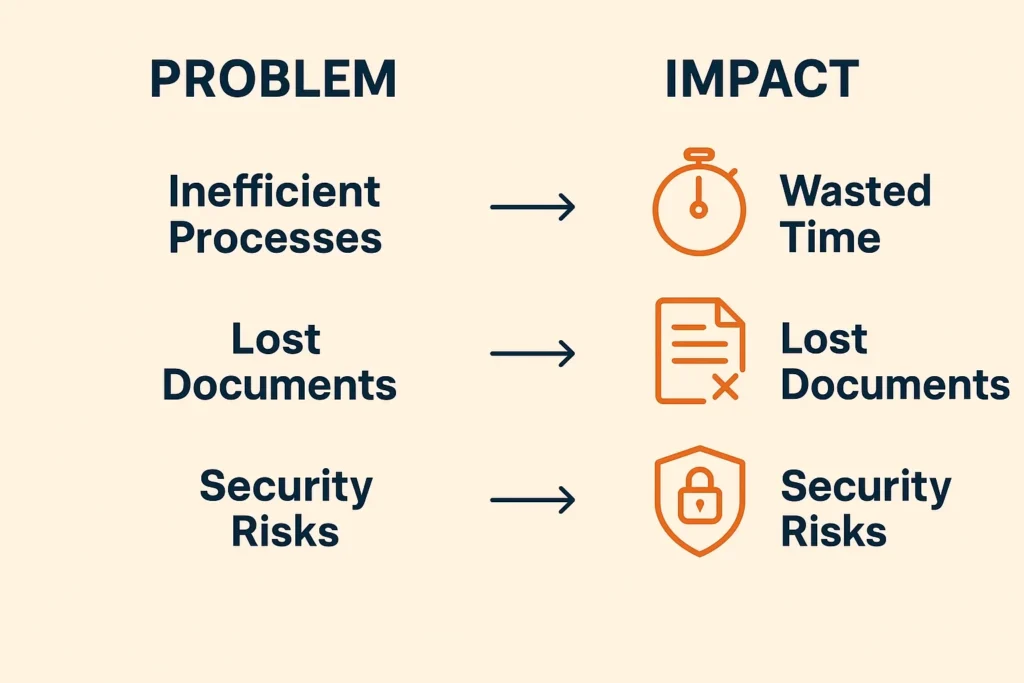Disclaimer: The information provided in this article is for general informational and educational purposes only. It does not constitute legal, financial, or professional advice. Organizations should consult qualified professionals before making decisions regarding document management systems, data security, compliance, or related technology solutions. While we strive for accuracy, we do not guarantee the completeness, reliability, or suitability of the content for your specific circumstances.
Modern business change is relentless, and efficient document control is crucial for productivity. Many organizations still rely on outdated methods, leading to lost productivity, scattered information, and potential data risks. According to industry reports, teams lose several hours per week searching for misplaced files or outdated versions.
Entity management software and intelligent systems help teams optimize efforts and protect data. These solutions are designed to organize, streamline collaboration, automate tasks, and secure information. They simplify information retrieval, transforming how teams work toward their goals. By integrating automation and AI, teams can reduce manual workloads, enhance accuracy, and maintain consistent documentation across departments.
Embracing these tools is essential in the context of remote work and digital shifts. Automated, AI-driven systems enable companies to stay competitive, enhance communication, and prevent issues such as version errors and misplaced files. They also support compliance and audits, enabling confident operations. In today’s hybrid work environments, document accessibility and control are no longer optional; they are strategic advantages. Many now view modern document control as crucial to collaboration, streamlined workflows, and effective client service in hybrid setups.
Challenges of Traditional Document Management

Traditional Information management, primarily based on paper or local storage, can lead to numerous challenges, including disorganization, version control issues, security risks, and inefficient collaboration. Disorganized files can lead to lost opportunities or duplicate work, while multiple versions can result in outdated information.
Implementing entity management software helps address these problems by centralizing data, ensuring version control, and enhancing security. Without such tools, a lack of centralized control over document access can expose organizations to data breach risks and compliance gaps. For instance, when sensitive client information is stored across multiple platforms without a unified oversight, the risk of unauthorized access increases significantly.
Inefficient collaboration can also result from the absence of real-time features or streamlined workflows, which wastes valuable time on tasks, file access, and merging comments. This inefficiency not only delays projects but can also reduce accountability and transparency across teams.
Benefits of Intelligent File Management
Intelligent document control enhances team performance by centralizing repositories and enabling easy document retrieval via metadata tags. It also improves collaboration through real-time editing and commenting while providing robust security through advanced permission settings and audit trails.
Automated workflows reduce errors and free up staff for higher-value work, thereby enhancing overall organizational efficiency. In addition, analytics and reporting features allow organizations to track document usage, identify process bottlenecks, and continuously improve efficiency.
Key Features of Modern Document Management Systems

Modern File management platforms address pressing organizational needs with AI integration, cloud accessibility, version control, and compliance management. AI improves search, automates classification, and performs repetitive tasks.
Cloud solutions provide anytime, anywhere access for remote and hybrid teams, promoting seamless collaboration across time zones. Automated version tracking reduces errors and lost work. Built-in compliance frameworks enable organizations to meet standards such as GDPR, HIPAA, and SOX. These systems often include encryption, multi-factor authentication, and detailed activity logs to ensure data integrity and audit readiness.
Steps to Implementing a Smarter Document Management System
To successfully deploy an advanced document control system, assess current processes, define requirements, select the right system based on ease of use, scalability, security features, and integration with your existing tech stack.
Develop a phased rollout plan, and continually monitor and optimize processes and permissions. This involves identifying bottlenecks, defining requirements, evaluating solutions, developing a rollout plan, and collecting feedback. Training staff and setting clear usage policies are also essential steps to ensure smooth adoption and long-term success.
Conclusion
More innovative File management systems do far more than store files; they transform how teams work together. By resolving persistent challenges in organization, collaboration, and security, intelligent platforms empower organizations of all sizes to operate with agility and confidence.
As remote and hybrid work continue to shape the business landscape, adopting a modern File management solution is essential for steering teams toward sustained success. Ultimately, investing in intelligent Information management is not just a technological upgrade; it’s a strategic move that shapes the future of digital collaboration.










